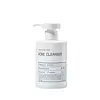What's inside
What's inside
 Key Ingredients
Key Ingredients

No key ingredients
 Benefits
Benefits

 Concerns
Concerns

 Ingredients Side-by-side
Ingredients Side-by-side

Water
Skin ConditioningSodium Laureth Sulfate
CleansingGlycerin
HumectantMyristic Acid
CleansingCocamidopropyl Betaine
CleansingLauric Acid
CleansingLauramide DEA
Potassium Hydroxide
BufferingButylene Glycol
HumectantSalicylic Acid
MaskingGlyceryl Caprate
EmollientPolyglyceryl-2 Laurate
EmulsifyingPolyglyceryl-10 Laurate
Skin ConditioningPEG-150 Pentaerythrityl Tetrastearate
EmulsifyingLavandula Angustifolia Oil
MaskingAloe Barbadensis Leaf Extract
EmollientCamellia Sinensis Leaf Extract
AntimicrobialTetrasodium EDTA
Methylparaben
PreservativeLinalool
PerfumingWater, Sodium Laureth Sulfate, Glycerin, Myristic Acid, Cocamidopropyl Betaine, Lauric Acid, Lauramide DEA, Potassium Hydroxide, Butylene Glycol, Salicylic Acid, Glyceryl Caprate, Polyglyceryl-2 Laurate, Polyglyceryl-10 Laurate, PEG-150 Pentaerythrityl Tetrastearate, Lavandula Angustifolia Oil, Aloe Barbadensis Leaf Extract, Camellia Sinensis Leaf Extract, Tetrasodium EDTA, Methylparaben, Linalool
Water
Skin ConditioningSodium Laureth Sulfate
CleansingCocamidopropyl Betaine
CleansingSodium Chloride
MaskingDecyl Glucoside
CleansingGlycerin
HumectantDisodium Cocoamphodiacetate
CleansingHoney Extract
HumectantPEG-60 Hydrogenated Castor Oil
EmulsifyingPolysorbate 20
EmulsifyingPEG-150 Distearate
EmulsifyingPolyquaternium-7
Citric Acid
BufferingDisodium EDTA
Butter Extract
EmollientBeta-Glucan
Skin ConditioningMagnesium Nitrate
Magnesium Chloride
Methylchloroisothiazolinone
PreservativeMethylisothiazolinone
PreservativeWater, Sodium Laureth Sulfate, Cocamidopropyl Betaine, Sodium Chloride, Decyl Glucoside, Glycerin, Disodium Cocoamphodiacetate, Honey Extract, PEG-60 Hydrogenated Castor Oil, Polysorbate 20, PEG-150 Distearate, Polyquaternium-7, Citric Acid, Disodium EDTA, Butter Extract, Beta-Glucan, Magnesium Nitrate, Magnesium Chloride, Methylchloroisothiazolinone, Methylisothiazolinone
Ingredients Explained
These ingredients are found in both products.
Ingredients higher up in an ingredient list are typically present in a larger amount.
Cocamidopropyl Betaine is a fatty acid created by mixing similar compounds in coconut oil and dimethylaminopropylamine, a compound with two amino groups.
This ingredient is a surfactant and cleanser. It helps gather the dirt, pollutants, and other impurities in your skin to be washed away. It also helps thicken a product and make the texture more creamy.
Being created from coconut oil means Cocamidopropyl Betaine is hydrating for the skin.
While Cocamidopropyl Betaine was believed to be an allergen, a study from 2012 disproved this. It found two compounds in unpure Cocamidopropyl Betaine to be the irritants: aminoamide and 3-dimethylaminopropylamine. High-grade and pure Cocamidopropyl Betaine did not induce allergic reactions during this study.
Learn more about Cocamidopropyl BetaineGlycerin is already naturally found in your skin. It helps moisturize and protect your skin.
A study from 2016 found glycerin to be more effective as a humectant than AHAs and hyaluronic acid.
As a humectant, it helps the skin stay hydrated by pulling moisture to your skin. The low molecular weight of glycerin allows it to pull moisture into the deeper layers of your skin.
Hydrated skin improves your skin barrier; Your skin barrier helps protect against irritants and bacteria.
Glycerin has also been found to have antimicrobial and antiviral properties. Due to these properties, glycerin is often used in wound and burn treatments.
In cosmetics, glycerin is usually derived from plants such as soybean or palm. However, it can also be sourced from animals, such as tallow or animal fat.
This ingredient is organic, colorless, odorless, and non-toxic.
Glycerin is the name for this ingredient in American English. British English uses Glycerol/Glycerine.
Learn more about GlycerinSodium Laureth Sulfate (SLES) is a foaming, cleansing, and emulsifying ingredient. It is created from palm kernel oil or coconut oil. SLES is not the same as sodium lauryl sulfate. It is much milder and less likely to irritate.
SLES helps create foam in personal products. It also prevents ingredients from separating, helping to elongate the shelf life.
Sodium Laureth Sulfate is a type of sulfate. It can be drying. We recommend speaking with a professional about using this ingredient if you have concerns.
Learn more about Sodium Laureth SulfateWater. It's the most common cosmetic ingredient of all. You'll usually see it at the top of ingredient lists, meaning that it makes up the largest part of the product.
So why is it so popular? Water most often acts as a solvent - this means that it helps dissolve other ingredients into the formulation.
You'll also recognize water as that liquid we all need to stay alive. If you see this, drink a glass of water. Stay hydrated!
Learn more about Water